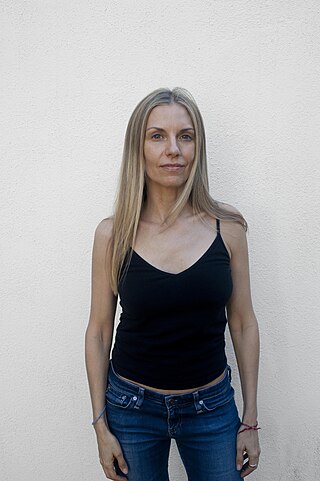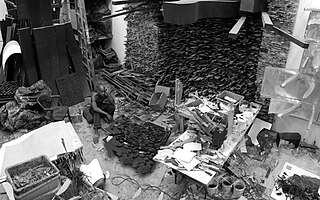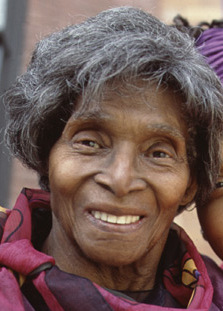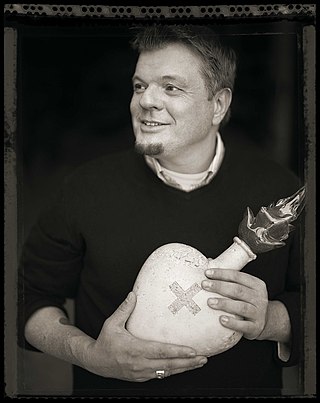
The Smithsonian American Art Museum is a museum in Washington, D.C., part of the Smithsonian Institution. Together with its branch museum, the Renwick Gallery, SAAM holds one of the world's largest and most inclusive collections of art, from the colonial period to the present, made in the United States. More than 7,000 artists are represented in the museum's collection. Most exhibitions are held in the museum's main building, the Old Patent Office Building, while craft-focused exhibitions are shown in the Renwick Gallery.
Lowery Stokes Sims is an American art historian and curator of modern and contemporary art known for her expertise in the work of African, African American, Latinx, Native and Asian American artists such as Wifredo Lam, Fritz Scholder, Romare Bearden, Joyce J. Scott and others. She served on the curatorial staff of the Metropolitan Museum of Art, the Studio Museum in Harlem, and the Museum of Arts and Design. She has frequently served as a guest curator, lectured internationally and published extensively, and has received many public appointments. Sims was featured in the 2010 documentary film !Women Art Revolution.

The Museum of Arts and Design (MAD), based in Manhattan, New York City, collects, displays, and interprets objects that document contemporary and historic innovation in craft, art, and design. In its exhibitions and educational programs, the museum celebrates the creative process through which materials are crafted into works that enhance contemporary life.

Keith Anthony Morrison, Commander of Distinction (C.D.), born May 20, 1942), is a Jamaican-born painter, printmaker, educator, critic, curator and administrator.
Robert H. Colescott was an American painter. He is known for satirical genre and crowd subjects, often conveying his exuberant, comical, or bitter reflections on being African American. He studied with Fernand Léger in Paris. Colescott's work is in many major public collections, including the Albright-Knox in Buffalo, the Museum of Modern Art in New York City, the San Francisco Museum of Modern Art, the Museum of Fine Arts, Boston, the Hirshhorn Museum and Sculpture Garden, the Baltimore Museum of Art and the Crystal Bridges Museum of American Art.

Sonya Clark is an American artist of Afro-Caribbean heritage. Clark is a fiber artist known for using a variety of materials including human hair and combs to address race, culture, class, and history. Her beaded headdress assemblages and braided wig series of the late 1990s, which received critical acclaim, evoked African traditions of personal adornment and moved these common forms into the realm of personal and political expression. Although African art and her Caribbean background are important influences, Clark also builds on practices of assemblage and accumulation used by artists such as Betye Saar and David Hammons.

Liza Lou is an American visual artist. She is best known for producing large scale sculpture using glass beads. Lou ran a studio in Durban, South Africa from 2005 to 2014. She currently has a nomadic practice, working mostly outdoors in the Mojave Desert in southern California. Lou's work is grounded in domestic craft and intersects with the larger social economy.
Whitfield Lovell is a contemporary African-American artist who is known primarily for his drawings of African-American individuals from the first half of the 20th century. Lovell creates these drawings in pencil, oil stick, or charcoal on paper, wood, or directly on walls. In his most recent work, these drawings are paired with found objects that Lovell collects at flea markets and antique shops.
Adelyn Dohme Breeskin (1896–1986) was an American curator, museum director, and art historian known for her longtime leadership of the Baltimore Museum of Art and Mary Cassatt scholarship.
Paul J. Smith was an arts administrator, curator, and artist based in New York. Smith was professionally involved with the art, craft, and design fields since the early 1950s and was closely associated with the twentieth-century studio craft movement in the United States. He joined the staff of the American Craftsmen's Council in 1957, and in 1963 was appointed Director of the Museum of Contemporary Crafts, a position he held for the next 25 years. In September 1987, he assumed the title of director emeritus and continued to work as an independent curator and consultant for museums, arts organizations, and collectors.

Leonardo Drew is a contemporary artist based in Brooklyn, New York. He creates sculptures from natural materials and through processes of oxidation, burning, and decay, Drew transforms these objects into massive sculptures that critique social injustices and the cyclical nature of existence.
Martha Jackson Jarvis is an American artist known for her mixed-media installations that explore aspects of African, African American, and Native American spirituality, ecological concerns, and the role of women in preserving indigenous cultures. Her installations are composed using a variety of natural materials including terracotta, sand, copper, recycled stone, glass, wood and coal. Her sculptures and installations are often site-specific, designed to interact with their surroundings and create a sense of place. Her works often focus on the history and culture of African Americans in the southern United States. In her exhibition at the Corcoran, Jarvis featured over 100 big collard green leaves, numerous carp and a live Potomac catfish.

Elizabeth Talford Scott was an American artist, known for her quilts.

Catherine Elizabeth Cooke was an American designer principally known for her jewelry. She has been called "an icon within the tradition of modernist jewelry" and "a seminal figure in American Modernist studio jewelry". Her pieces have been shown nationally and internationally and are included in a number of museum collections, including the Museum of Modern Art (MOMA) in New York. She is regarded as an important role model for other artists and craftspeople.
Leslie King-Hammond is an American artist, curator and art historian who is the Founding Director of the Center for Race and Culture at the Maryland Institute College of Art, where she is also Graduate Dean Emeritus.

Michael Janis is an American artist currently residing in Washington, DC where he is one of the directors of the Washington Glass School. He is known for his work on glass using the exceptionally difficult sgraffito technique on glass.

Tim Tate is an American artist and the co-founder of the Washington Glass School in the Greater Washington, DC capital area. The school was founded in 2001 and is now the second largest warm glass school in the United States. Tate was diagnosed as HIV positive in 1989 and was told that he had a year left to live. As a result, Tate decided to begin working with glass in order to leave a legacy behind. Over a decade ago, Tate began incorporating video and embedded electronics into his glass sculptures, thus becoming one of the first artists to migrate and integrate the relatively new form of video art into sculptural works. In 2019 he was selected to represent the United States at the sixth edition of the GLASSTRESS exhibition at the Venice Biennale.
Andrew Lyght is a contemporary artist living in Kingston, New York. Lyght is a mixed media artist, often combining drawings, painterly elements, industrial objects, and sculptural wooden assemblages.
Lloyd Eldred Herman (1936-2023) was an American arts administrator, curator, writer, museum planner and acknowledged expert on contemporary craft. He was known for being the founding Director of the Renwick Gallery of the Smithsonian American Art Museum in Washington D.C., from 1971 to 1986.
Objects: USA (1969) was a groundbreaking exhibition considered a watershed in the history of the American studio craft movement. It "blurred lines between art and craft, artist and artisan". The exhibition featured a survey collection of craft works by artists from across the United States. Artists were approached and works chosen by New York gallery owner Lee Nordness and curator Paul J. Smith, the director of the Museum of Contemporary Crafts. The exhibition was funded by S. C. Johnson & Son, which purchased the pieces for the exhibition and later donated many of them to American museums. The Objects: USA exhibition appeared at thirty-three locations in the United States and Europe. The accompanying exhibition catalog Objects: USA (1970) became a classic reference work.













